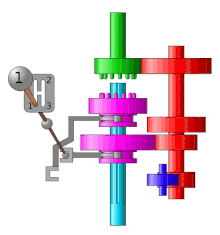
Back Transmisión no sincronizada Spanish Transmission non synchronisée French ノンシンクロトランスミッション Japanese Usynkronisert girkasse NB


A non-synchronous transmission, also called a crash gearbox, is a form of manual transmission based on gears that do not use synchronizing mechanisms. They require the driver to manually synchronize the transmission's input speed (engine RPM) and output speed (driveshaft speed).
Non-synchronous transmissions are found primarily in various types of industrial machinery; such as tractors and semi-tractors. Non-synchronous manual transmissions are also found on motorcycles, in the form of constant-mesh sequential manual transmissions.[1][2] Prior to the 1950s and 1960s, most cars used constant-mesh (and also sliding-mesh) but non-synchronous transmissions.
- ^ "Types of Motorcycle Transmission @ Top Speed". 7 November 2019.
- ^ Brain, Marshall (4 April 2003). "How Sequential Gearboxes Work". HowStuffWorks. Retrieved 16 May 2021.